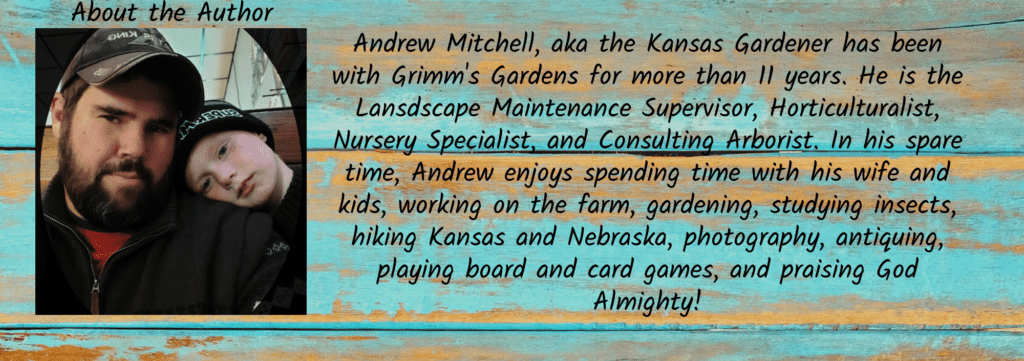Long-lived perennials should be a staple in the garden, right? Well, with so many options these days for perennials and plants, finding the truly long-lived ones is not as easy. Some of our Grandmother’s favorite flowers are the long-lived plants we desire now, but cannot find. Sometimes we need to go back to our roots to get those easy to grow, long-lived perennials which thrived in all kinds of conditions.
My Grandma Trost was instrumental in cultivating my love of flowers. Not only did her and grandpa collect tree seeds for planting wherever they went, they also grew an abundance of flowers. Fernleaf, tree, and herbaceous peonies had well-deserved places in her garden. But even more things I discovered in her garden after she was long gone.
But how can gardeners know which perennials will be long-lived? One way is to trial things in their own gardens. Another way is to ask those who have been growing perennials for decades. One of my goals is to trial as many different types of plants in my gardens, so I can relate my experiences to others. And I have discovered many long-lived, tough perennials for the Central Great Plains.
Sun Loving Long-Lived Perennials
Who would not want perennials to be long-lived and grow in our tough conditions? Here in the Central Great Plains, we can get harsh or mild winters, wet or dry springs, summers, and falls, and extreme temperature swings anytime. Wait 5 minutes, they say, and the weather will change. In the winter of 2021-22, we had several cases of extreme temperature swings, where it went from above 60 degrees to under 30 degrees in less than 24 hours. That is really hard on plants.
There are a number of long-lived perennials that can withstand these and other tough conditions. And besides the climate conditions, long-lived perennials need to be mostly disease and insect resistant to thrive. Let us take a look at some of those plants now.
Baptisia
One of my favorite perennials, I now have 11 different plants, 9 cultivars and 2 different species. I cannot get enough of these native plants. Three species of Baptisia are native to the Central Great Plains, and many of the cultivars are derived from them. They can withstand not only our changing weather patterns, but our insects, diseases, and wildlife.
A member of the Legume Family, Baptisia set deep roots, which reach many feet underground for nutrients and moisture. Because of their relationship with bacteria and fungi, they can utilize the production of nitrogen famous to legumes. This gives them a natural fertilizer for quick growth each spring.
My first Baptisia was the cultivar ‘Twilite Prairieblues’ which I have moved once since originally planting. In the garden, Baptisia is well-behaved, only sometimes producing viable seeds. Once the stems die down in late fall, the whole plant can be pushed off the roots without affecting it. There are a few insects which feed on the seeds and leaves of the plant, but they generally cause only minimal damage. The only cultural damage I have observed was from overwatering.

Cultivars Include
- Pink Lemonade
- Solar Flare
- Lunar Eclipse
- Twilite Prairieblues
- Sparkling Sapphires
- Cherries Jubilee
- Lemon Meringue
- Purple Smoke
- Vanilla Cream
- Honey Roasted
- Burgundy Blast
- Indigo Spires
- Dutch Chocolate
Peonies
It can be hard to find an older garden without a row of peonies planted randomly in the yard. Almost every older garden has at least one. Why did our grandmothers plant peonies in rows? My grandma had 6 rows, 12 feet long, next to the vegetable garden. Now it is overgrown with trees and weeds, but the peonies are still there. These herbaceous peonies were likely planted by my great-grandma sometime in the 1880s. There is a photo of the original house and garden, with the peony bed in it, from the 1920s.
One of the things I remember the most about my grandma was her fernleaf peonies. These double flowered, cutleaf peonies only grow 6 to 10 inches tall by 12 inches wide, but the fragrance of the deep red blooms was heavenly. Even now, I can recall the scent of those peonies. Since my grandma’s passing, my mom and aunts have dug up and given starts of fernleaf peonies to every member of the family. I enjoy them in my own garden. And most of these are easily 30 years old.
Also on the list peonies are tree peonies, which grow 4 to 5 feet tall and wide, and prefer part to nearly full shade in our hot summers. Another long-lived perennial, tree peonies come in a wider variety of flower colors than other peonies, with yellow, white, and multicolor being popular. I have a yellow one in my entry garden.
Cultivars Include
- Double Fernleaf Peony
- Pink Cameo
- Bartzella
- Kansas
- Festiva Maxima
- Bowl of Cream
- High Noon
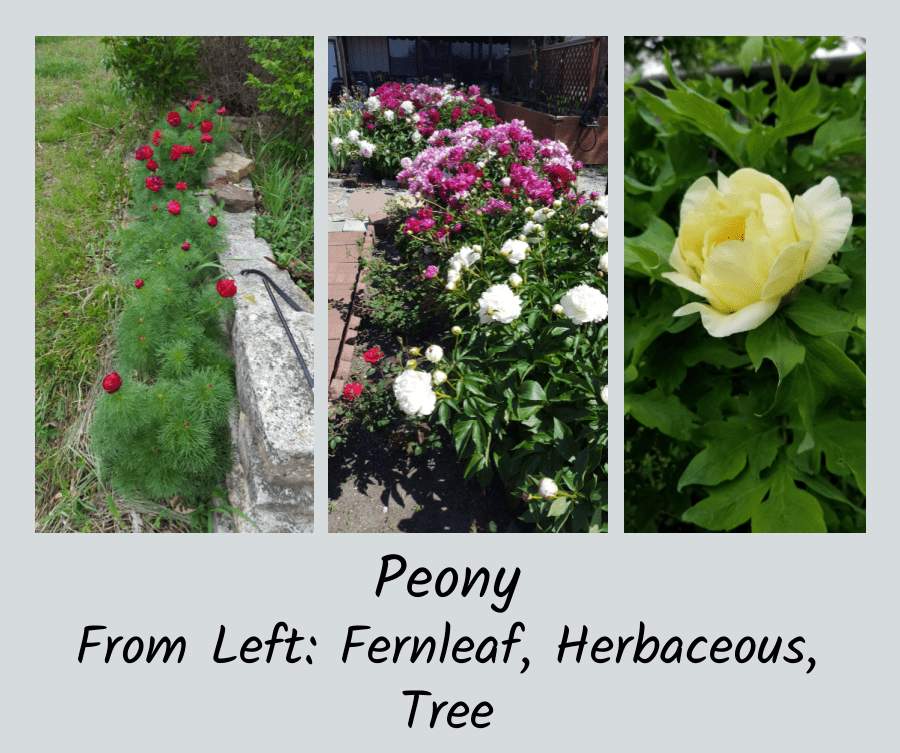
Irises
If we did not divide irises regularly, they would likely not live as long as they do. However, there is a ring of bearded irises on some of my family’s farm ground that has been there since 1890. It has never been divided, only grazed by cattle. In my own garden, I inherited clumps of bearded irises when we bought the land, on which a farmhouse once stood.
I have also trialed and grown a variety of Siberian irises, and I am well pleased with their longevity in the garden. At one of my best customer’s, there is a bed of Siberian iris ‘Caesar’s Brother’, which has been growing there since the landscape was installed 25 years ago. I have only done minimal division on this bed, removing clumps which crowd other plants and the edging.
Irises, if planted right, will out-live many other perennials. While their rhizomes are not deep dwellers, they do send roots a few feet into the ground. Bearded irises prefer well-drained, almost dry soil, while Siberian, Louisiana, & Japanese iris prefer wetter soils, but not standing water. Even when they do get diseases and insect issues, they rarely die out completely.
Siberian Iris Cultivars Include
- Caesar’s Brother
- Butter and Sugar
- Kaboom
- Painted Woman
- Pink Parfait
- Shaker’s Prayer
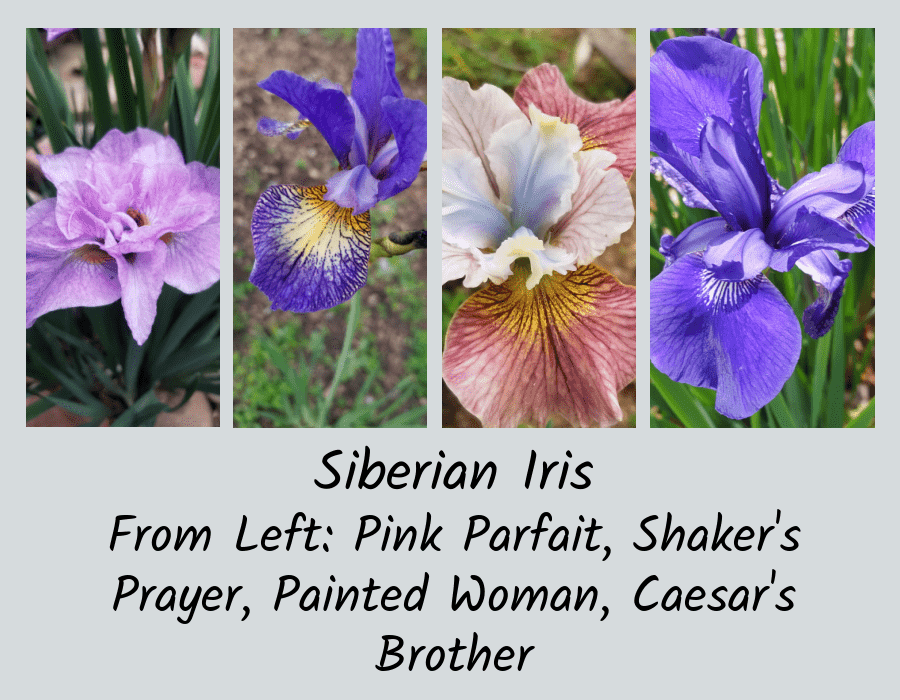
Bearded Iris Cultivars Include (There are several thousand)
- Welcome
- Harvest of Memories
- Candy Apple
- Concertina
- Immortality
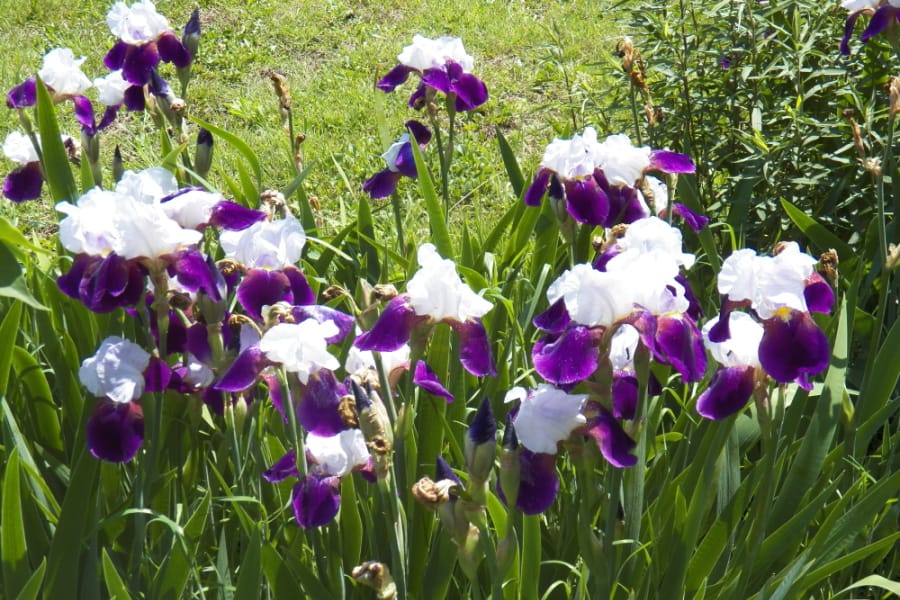
Rudbeckia
While there are several cultivars and types of Rudbeckia which are annuals, biennials, or short-lived perennials, there are several which are long-lived perennials. Among these are R. maxima, R. laciniata, and R. subtomentosa ‘Henry Eilers’. Again, from my grandma’s garden, another long-lived perennial shows up. When I finally noticed the tall yellow flowers of R. laciniata ‘Goldquelle’, a unique double flowering variety, I could not believe it was a Rudbeckia. And now it is in my garden.
These clump forming Rudbeckia species are not only tough and disease free, they are excellent bloomers. ‘Henry Eilers’ and the new cultivar ‘Little Henry’ bloom in my gardens from July to October. I feel I could not have a great garden without every one of these Rudbeckia species.
Cultivars Include
- Henry Eilers
- Little Henry
- Goldquelle
- Hortensia
- Golden Glow
- Herbstonne
- Autumn Sun

Sea Lavender
One of the little known plants in the Central Great Plains, sea lavender is a tough and long-lived perennial. I first saw it in Jeryl Grimm’s garden. It thrives in all sorts of tough conditions, even withstanding salt in winter. The leaves are wide and gray-green. In summer, tiny purple flowers top the plants for weeks on end.
And I have yet to see anything eat the leaves or damage the flowers. While I do enjoy seeing caterpillars on many of my plants, it is nice to have a few on which nothing eats. The sea lavender plant in my garden is 6 years old, and has no notion of dying. Also, it makes a great cut flower, similar to statice.

Prairie Dock
One of the many Silphium species in our area, prairie dock is an extremely long-lived perennial. Before flowering the roots of this plant may grow for several years, storing up energy. Once it does bloom, the stems can be 5 to 8 feet tall and topped with orange-yellow, sunflower like bloom heads. The leaves of prairie dock are huge, looking almost like horseradish leaves. I have found individual plants that are known to be over 30 years old.

Daylilies
When it comes to gardening in the Central Great Plains, almost everyone has daylilies. It can be hard to imagine a garden without them. Would you believe that I did not have any for the first few years of my own home? Thanks to overplanting of a few varieties, my like for them was soured for awhile. But now I have dozens of plants.
Daylilies do need division every 5 to 10 years to keep up performance, and the easiest way to do this is to just dig a couple fans from the middle of the plant. That is how I got all but one of my daylilies. Some of my past customers have been daylily collectors, which acres of plants, some of which were 40 years old. Daylilies do get some pests, such as aphids, and damage from deer, but generally they are trouble free.
Cultivars Include
- South Seas
- Persian Ruby
- Desert Flame
- Wineberry Candy
- Gentle Shepherd
- Mauna Loa
- Ruby Spider
- Primal Scream
- Hungry Eyes
- Inkheart
- Kokomo Sunset
- Mildred Mitchell

Hardy Hibiscus
Once, these were the most sought-out perennials for summer heat. Now, with the emergence of Japanese beetles, they are not as popular as they once were. But they are still popular. New varieties come out each year, often with multicolored flowers or dark colored leaves. Because hardy hibiscus is a long-lived perennial, they may outlast the beetles.
If planted in well-drained to moist soils, in full, hot sun, hardy hibiscus can grow and thrive for decades in the same place. This is why they are often used in tough spots in landscape designs. They even thrive in beds “mulched” with rock or gravel, when many other plants die after a few years. A clump of hardy hibiscus can grow in the same 2 foot hole in weed barrier for 20 years without being suffocated, if properly pruned back each fall or early spring.
Besides the dreaded Japanese beetle, which feeds on the leaves and flowers, there are few if any other issues.
Cultivars Include
- Holy Grail
- Luna Red
- Cherry Cheesecake
- Cranberry Crush
- French Vanilla
- Berry Awesome
- Edge of Night
- Dark Mystery
- Perfect Storm
- Spinderella
- Luna White

Tall Sedum
Also known as Live Forever, tall sedums are wonderful plants. When I first moved out to Northeast Kansas, 14 years ago, I had never heard anyone call this plant live forever. Quite an interesting common name. Anyways, tall sedum can live for quite a long time, as long as it is grow in well-drained soil. It does not like wet feet, and will die if over-irrigated or flooded. Aphids can be an issue, but are easily treated with insecticidal soap.
One of the best reasons for growing tall sedums is there attractiveness to pollinators in the landscape. In late summer, flowers erupt in bloom on the 2 foot tall plants, with bees, butterflies, and other insects enjoying the nectar.
Cultivars Include
- Autumn Joy
- Autumn Fire
- Thundercloud
- Lemonjade
- Coraljade
- Double Martini
- Night Embers
- Carl
- Autumn Charm

Shade Loving Long-Lived Perennials
Long-lived perennials in for the shade garden make more sense than even sun loving ones, because there is less light in the shade, and plants typically grow slower in shade. So who would not one their shade plants to live for decades? I know I do.
Lenten Rose
This is one of the perennials I discovered in my grandmother’s garden after she was gone. I am sure I noticed it before that, but did not give it much thought. Anyways, I found out that her Lenten rose (Hellebore) had been in the garden for more than 20 years before I recognized it. And then, I was able to transplant it into my own garden. Now, I know that that particular plant is over 30 years and still going. In mid-March, it begins blooming in my shade garden, and usually blooms for 4 to 8 weeks.
In recent years, much progress has been made in hybridizing and producing Hellebores which hold their flowers up, and in flower color. Older varieties have dropping flowers and are less showy. You can find a large variety of flower colors in garden centers across the country. Lenten roses are not only long-lived, they are tough and drought tolerant. I have not seen any insect or disease problems, and the only maintenance is to clip off last-seasons leaves in early spring.
Cultivars Include
- Painted Doubles
- Ivory Prince
- Snow Fever
- Cinnamon Snow
- Searchlight
- Penny’s Pink
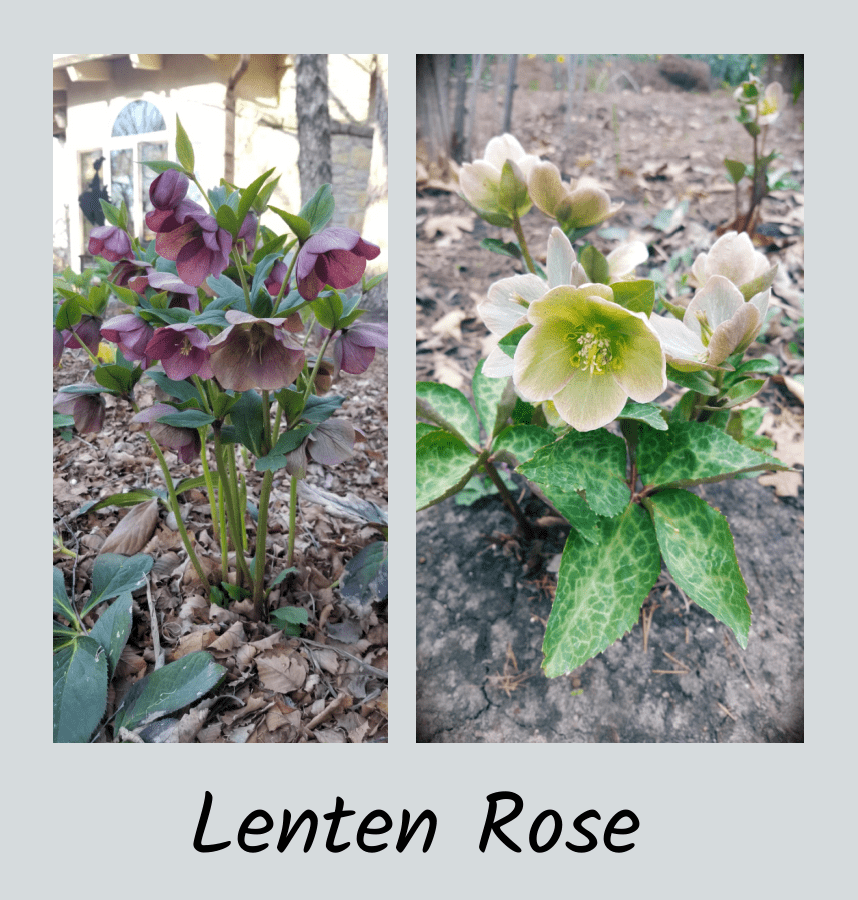
Hosta
Everyone has one right? If you love your shade garden, and you are not a native purist, then you likely have some hostas in your garden. Even without the recommended division every 5 to 10 years, hostas can live for decades. Maybe some live for centuries, who knows? Anyways, there are several hundred to a few thousand varieties to choose from, for every niche in the shade garden.
I particularly love the large leafed varieites and those with variegation of white and green. Mixed with my native shade perennials and understory trees, hostas really add depth to the garden. Their biggest issue is with slugs and snails, which are often eaten up by small snakes, toads, and lizards in my garden. Maintenance care is fairly easy, just remove the the dead leaves and stems in late fall or early spring.
Cultivars Include
- Praying Hands
- Velvet Moon
- Diamond Lake
- Party Streamers
- Waterslide
- Love Pat
- Blue Angel
- Francee
- Mouse Ears
- Patriot
- Humpback Whale
- Coast to Coast

Bleeding Hearts
One of my all-time favorite long-lived perennials, bleeding hearts never need dividing, and can live for decades. There are native and non-native types, and the non-natives make the best garden varieties. Old-fashioned bleeding hearts are usually pink or white flowers, with green or chartreuse leaves. I know of no pest problems with this plant.
Besides growing long and well in the shade garden, the flower stems are great for arrangements and the flowers attract early hummingbirds and long-tongued bees.
Cultivars Includes
- Pink Diamonds
- Old-fashioned White
- Old-fashioned Pink
- White Gold
- Gold Heart
- Valentine

Toad Lilies
One of the most unique long-lived perennials for the shade garden, toad lilies are often the last thing to bloom in autumn. The delicate looking plants almost seem an after-thought to gardeners, as the leaves blend in among the hostas and coral bells. But once autumn comes, the flowers on these plants open up with spotted petals that are truly one of a kind.
Toad lilies grow just a few feet tall and wide in small clumps, but can live for many years in the garden. I know of a clump at Grimm’s Gardens that has been in the same place since the 1990s.

Other Plants
I have not been shade gardening long enough to know how many other plants are long-lived in the garden, but I suspect that the following list of plants could be so.
- Ligularia
- Kirengshoma
- Rodgersia
- Tiarella
Conclusion
Long-lived perennials for the garden include some large collections of plants, such as those of hosta, iris, and daylily, and some little used plants such as prairie dock and toad lily. But once you discover which plants are the longest lived, you will begin to add them to your garden too.
Happy planting!
